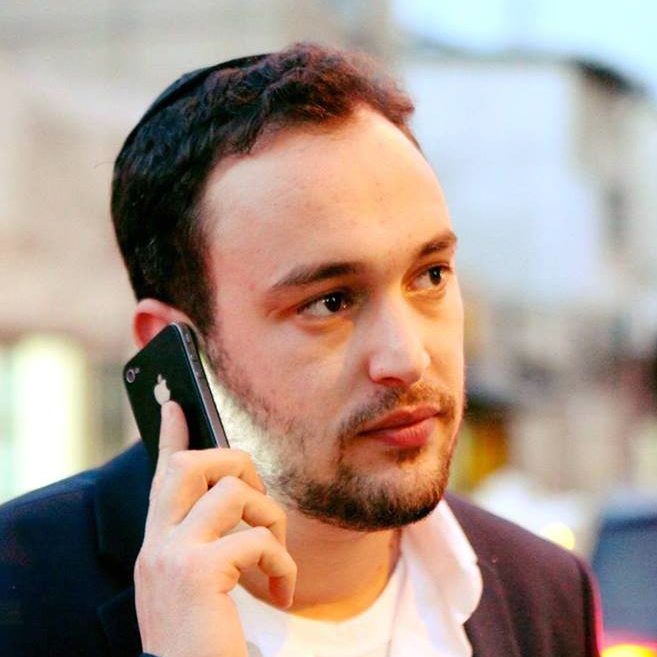Facts in the Ground

Eighty years after the graveyard was razed, Rav Yechezkel of Kuzmir’s progeny have returned. “The tzaddik senses that we’ve come back,” said the Modzhitzer Rebbe, standing on the cemetery-turned-soccer field

Photos: Ezra Trabelsi, Modzhitz archives
"W
e must have seemed a strange sight — a delegation of chassidim dressed in black, holding umbrellas in an attempt to shield ourselves from the merciless rain, stepping carefully onto a Polish soccer field.”
For Rav Shlomo Tzvi Hersh Taub, the son of the current Modzhitzer Rebbe shlita, the events of that winter day this past Shevat are so memorable that he can immediately summon up the scene in full detail.
“We made our way to the middle of the field and spread a blue paroches with golden embroidered letters over the grass. The Rebbe stood in the center of our group, directly before the paroches. His face ablaze, he began reciting Tehillim. Slowly but surely, our tears began to fall. Beneath this soccer field lay our ancestor, the holy Rav Yechezkel of Kuzmir. And while it may have been his yahrtzeit, there was no ohel, there were no candles, and there were no Jewish graves in the vicinity. In fact, there were no graves at all.”
When the Tehillim had concluded, silence filled the air. The Modzhitzer Rebbe began addressing the crowd. “The tzaddik knows that we are returning to him,” he said. “Tzaddikim are considered alive even after they have died — their merit brings our prayers upward, especially when we daven at their graves. For so many years, the tzaddik’s grave has remained abandoned. No one came to this kever, which had been a place of communal prayer for so many years.
“Now,” the Rebbe continued, his voice steadily rising, “we have returned to this place, 80 years after the tziyun was abandoned. The tzaddik senses that we have come back to visit his holy grave. Our prayers at the gravesite of our holy Rebbe, certainly at this time, on the day of his yahrtzeit, can bring about many salvations.”
As the tefillos wound down, a humming sound began drifting through the air. The Rebbe started to sing, and then led everyone in a spirited dance. They proceeded to make their way, singing and dancing and praying, through the streets of the town where their ancestors once walked.
Old or New
It’s not every day that the son of a prominent chassidish rebbe consents to an interview of this nature. But Rav Shlomo Hersh Taub is fighting the battle of a lifetime. Over the past five years, he has visited Poland dozens of times and has met with countless government officials, lawyers, jurists, and researchers, in an effort to locate the kever of his ancestor and to erect a proper tombstone.
As the quest gained momentum, the tiny town of Kazimierz Dolny (called Kuzmir among traditional Jews) became a magnet for hundreds of chassidim, who have been visiting it on a regular basis. Those visits have communicated to the Poles that the desecration perpetrated in this town carries a heavy price tag.
The Rebbe of Kuzmir, Rav Yechezkel Taub ztz”l, passed away in Shevat of 1856. A disciple of the Chozeh of Lublin, Rav Yechezkel was known for his unique approach to chassidus, which emphasized the avodah of davening and the profound power of music — hallmarks that still characterize the Modzhitzer chassidus today.
Thousands of Jews from Kuzmir and the adjacent towns escorted the Rebbe on his final journey 162 years ago, among them admorim and leaders such as Rav Shlomo of Radomsk, Rav Nosson Dovid of Shidlovtza, and Rav Yisroel Yitzchok of Radoshitz.
A few minutes before the levayah began, a question arose as to where the Rebbe should be buried. “There were two main cemeteries in Kuzmir,” Rav Shlomo Hersh explains. “One was the old cemetery, and the other, which was known as the new cemetery, had been inaugurated two decades before the Rebbe’s passing. The chevra kaddisha wanted to bury him in the new cemetery, but the chassidim wanted the Rebbe to be buried in the old cemetery, along with dozens of Jews who had been killed al kiddush Hashem.”
Oops! We could not locate your form.












